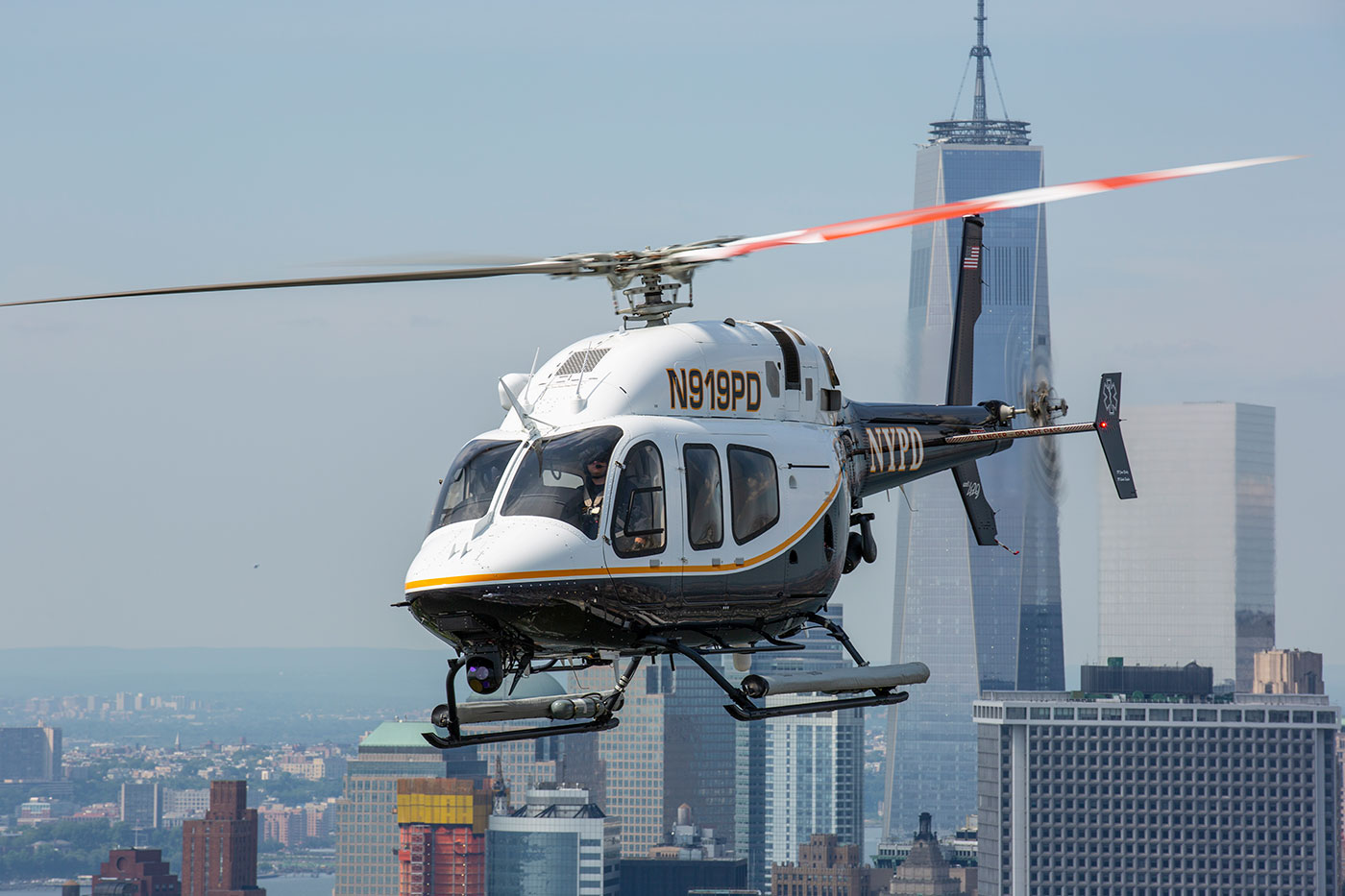Photos by Brent Bergan, with additional photos by Sheldon Cohen.
Two years ago, Detective Chris Maher responded to an overturned boat in Long Island while listening to emergency calls from the maritime distress channel 16. Maher rallied his crew and launched even before the request for assistance was made. Five minutes into his flight, he was asked to respond to the capsized 35-foot cabin cruiser. Boats in the area also responded to help rescue all the survivors in the water, but one person was unaccounted for.
Hearing the radio traffic, the crew suspected the worst, that a woman was trapped under the boat. When the NYPD’s Air Sea Rescue (ASR) unit responds, they typically launch a Bell 412, with two pilots, a crew chief and two scuba divers from the Harbor Unit. Very few police units or rescue units fly with rescue technicians outfitted with scuba gear. Thankfully the NYPD does, and this instance they deployed their divers to the overturned boat.
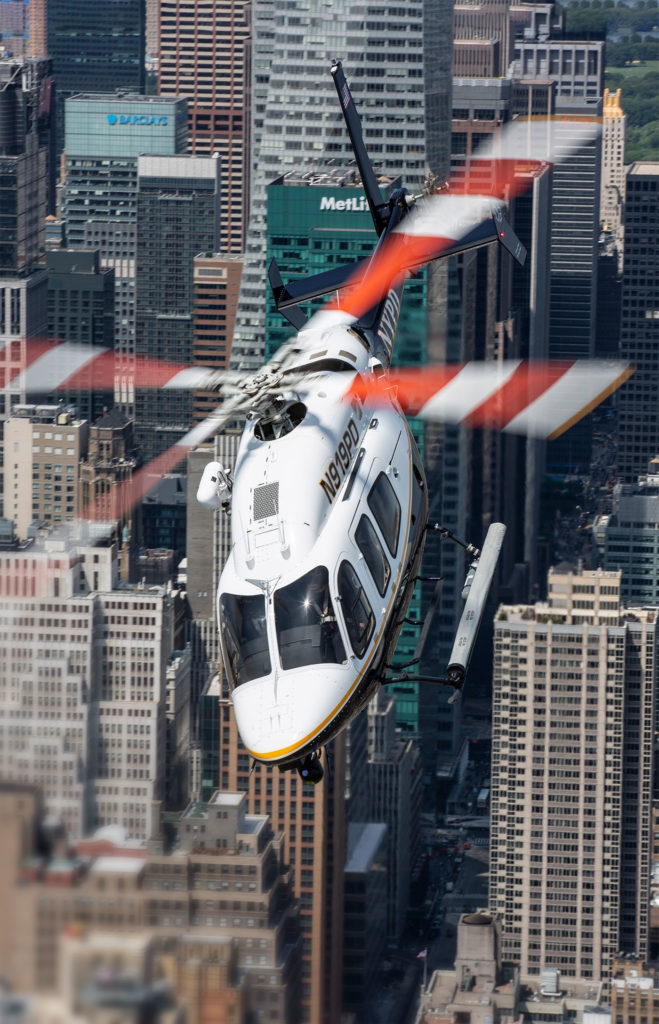
“We got there and just 80 percent of the boat was submerged, underwater,” Maher said. “We hoisted down two divers with full scuba equipment, and they actually found her in a forward compartment, in an air pocket.”
The woman didn’t want to leave, but the diver communicated the plan with hand signals, and pulled her under and to the surface of the water, saving her life. Air marine rescue is one of the many missions the NYPD conducts in one of the busiest and most iconic cities in the United States. The New York Police Department’s Aviation Unit covers the U.S. Coast Guard’s blind spot around New York City for maritime search-and-rescue. Every day the NYPD covers a 60-mile (95-kilometer) radius from the city.
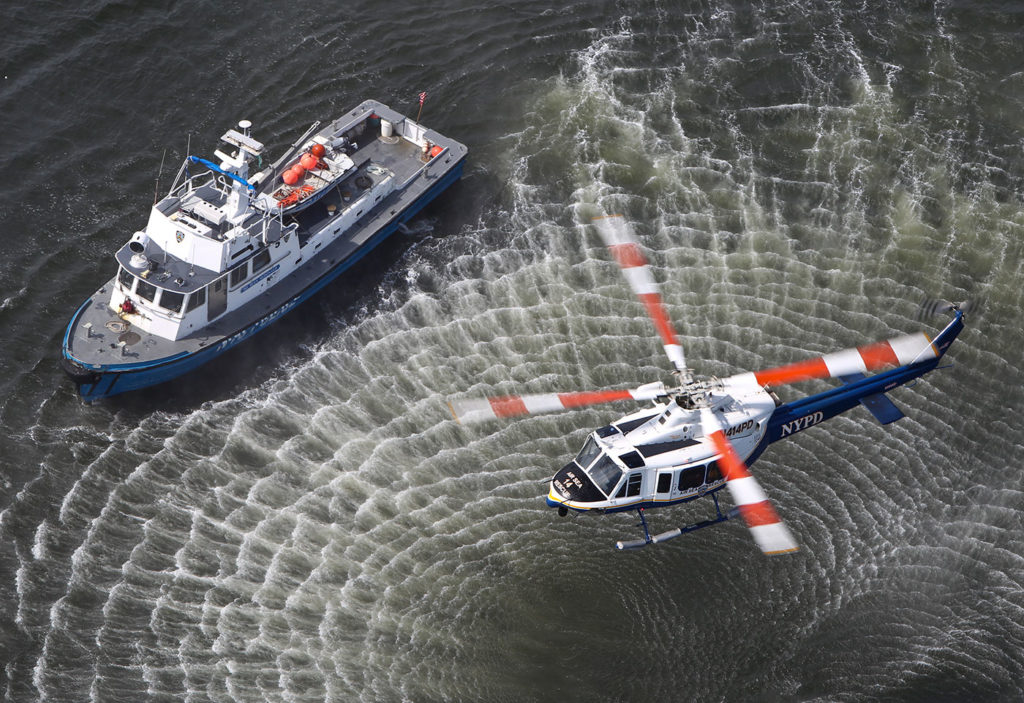
Multi-Mission over Manhattan
The NYPD’s aviation unit conducts a multitude of missions from maritime SAR, tactical operations with fast roping, rappelling, traditional police support, and rescue operations including mountain rescue, fire department support, aerial surveillance, Bambi Bucket operations, not to mention the near daily response to suicide attempts from the multiple bridges in and out of Manhattan.
Then, add in supporting counter-terrorism missions, radiation detection, big event support and the constant flow of dignitaries in and out of NYC including multiple visits by presidents with Secret Service support. The operational tempo is incredible, and the men and women who make it happen are all police officers.
“We’re police first, we want our guys to know what the troops are looking for,” said Lt. Tony Hernandez.
The NYPD operates seven helicopters out of Floyd Bennet Field in Brooklyn, New York. The department took over the air field from the U.S. Coast Guard in 1998 following a memorandum of understanding. The NYPD accepted the maritime response requirements within the New York City harbor and the surrounding 60 miles. Chief Pilot, Detective. Chris Delacruz said, “it’s one of the busiest waterways in the world,” where they respond to everything including cruise ship medevacs, fishing charter boat rescues, and injuries on tanker ships. Their primary ASR helicopter is the Bell 412.
“The 412 is the workhorse of the unit; when you think of us, you think Bell 412,” Delacruz said.

The NYPD air unit was one of the first police aviation units in the world when it began in 1929 with biplanes to chase down a barrage of barnstorming pilots back in the day. In 1948, the unit received its first Bell 47 helicopter, employing the very first helicopter in support of police activities. Today, the unit employs two Bell 412s, four Bell 429s and one Bell 407 for training to meet the multi-mission set of the NYPD. The Bell 412s operate as the primary Air Sea Rescue (ASR) aircraft, and the 429 operates as a patrol aircraft and a quick reaction force which is also fully mission capable with a hoist. The NYPD operates in three shifts, with two birds at the ready 24/7 to meet the mission demand. To make all this happen, the aviation unit is about 75 members strong with 40 pilots, 30 mechanics and five administration support members, all trained within the department.
“We’re very efficient at doing everything in house,” Delacruz said.
Jumping into Aviation
The absolute first step is the police academy and then three years on the job before you can apply for the aviation unit. For pilots, the aviation unit looks for officers with commercial fixed-wing or rotary ratings. The unit then uses its 407 to develop helicopter skills, as it has certified flight instructors (CFIs) on staff.
After initial pilot training, the CFIs will bring them into phase two, where we’ll show them how to do tactical flight officer [TFO] duties, which is our copilot,” Hernandez explained. “We show them the mission equipment, how to utilize the search light, how to utilize the camera, moving map, how to handle the radios. Once they do all that, then they progress onto becoming a pilot in command [PIC].”
The progression moves along from TFO to PIC from the 407 to the 429 to the 412. Hernandez said, “Air Sea Rescue is the best of the best.”
The level of training at the NYPD is substantial, and is a challenge to maintain currency in every mission set. Having an in-house simulator makes a big difference. The pilots can nearly get their instrument qualifications in the hangar, Delacruz said.
“We maintain our currency, where every day there’s at least two guys assigned in the simulator with that same instructor, and you’ll go over all of your approaches, any inadvertent, and any type of IMC conditions,” Delacruz said.
He further explained that all the pilots attend the factory school annually, but currency is maintained in-house. As far as the maritime rescue, Delacruz explained, “We work with Priority One, they helped us standardize and establish our whole rescue program.”
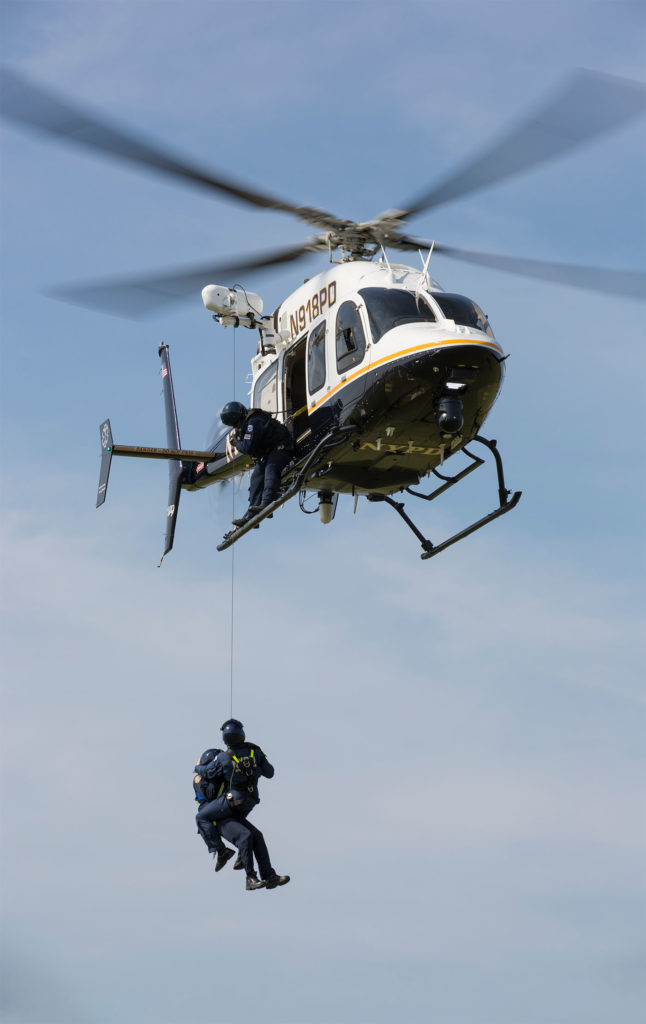
“You can fly with anybody here, I already know what he’s going to be asking of me, and he already knows what he’s expecting me to do in every position,” Delacruz said.
Hernandez stepped in to explain, “We have a standardization officer and his focus is standards. His job is to make sure that every pilot flies the same way, every TFO performs the same way, and every crew chief preforms the same way, so the idea is that any pilot and any copilot and crew chief will work the same way in any condition.”
“We’re very efficient at doing everything in house.”
Maintenance team leader and crew chief police officer, Cesar Pazmino, was a former U.S. Air Force maintainer and worked on A-10 Warthogs in Arizona before becoming a cop. After five years, he put in his letter to join the aviation unit, and after six years he became the to go-to guy for everything related to maintenance and training the crew chiefs. The maintenance crew is extremely active keeping their fleet flying and they do everything in house.
Maritime Rescue
Flying offshore at night on night vision goggles (NVGs) isn’t for the faint of heart. The NYPD takes this role very seriously, as the nearest U.S. Coast Guard units are Cape Cod, Massachusetts, to the east and Atlantic City, New Jersey, to the south. The NYPD Air Sea Rescue has a great relationship with the Coast Guard, and when necessary, its pilots are able to conduct the same search patterns the Coast Guard establishes looking for missing boaters, or whatever the situation may call for. The weather plays a significant role.
“We want to have at least one mile visibility and a 500-foot ceiling. If we’re launching at night time, then that increases to two miles visibility and 800-foot ceilings,” Hernandez said.
“That white ball antenna provides HD camera downlink to headquarters here at base, and any executive that’s on.”
All the aircraft are certified to fly instrument approaches, with both operational aircraft able to fly coupled GPS approaches. Their 412s are outfitted with a fairly standard maritime rescue package, including a rescue basket, an ambulatory victim extraction device (AVED) commonly known as a screamer suit, and a rescue strop. All of their aircraft are outfitted with a Wescam MX10, elcectro optical infrared (EO/IR) camera, and a Trakka Beam search light. One piece of gear that sets the NYPD apart is its downlink capability.
“That white ball antenna provides HD camera downlink to headquarters here at base, and any executive that’s on,” Pazamino said, meaning any captain or above can receive the helicopter’s feed on their cell phone providing the on-scene picture which provides critical situational awareness in emergency situations. The air unit will also send out a mobile team to provide the temporary operations center with a larger screen to help the situational awareness.
A typical fuel load provides about 75 minutes of flight time. The Bell 412 can only take about a half-tank of gas because of weight and power limitations. If they know they’re going offshore, they make adjustments.
“When we leave here, we’re already heavy, so we’re hoping we’re going to burn off fuel,” Pazamino said. “So, if we know we’re going out further, then we’ll take more [fuel] . . . anytime those offshore jobs pop up, we’ll dump on another 20 gallons.”

Essentially, fuel is added on to extend their range out to sea for them to pick up two survivors, and exchange people weight for the fuel-burn weight, adding an extra 20 minutes to their flight time. And 20 minutes on scene can make all the difference.
Because of the power and on-scene time capacity, the NYPD is looking to upgrade its Bell 412 to gain more power, capability and speed to meet their extensive mission set. Hernandez explained what goes into their calculus in making their decision for their next aircraft, “So it’s not just the capabilities of the aircraft, but we also look at the big picture. How much is it going to cost, how much is it going to cost to maintain, so everything gets taken into account when we decide on what the next helicopter is going to be.”
Traditional Police Work
Walking into their ready room around noon, about 10 cops were eating lunch around the table watching the 1980s cop movie, “48 Hours,” with Eddy Murphy and Nick Nolte.
“We eat and breathe this stuff,” Delacruz said of the movie, with a chuckle.
However, getting the word out about how the unit support the officers on the ground can be a challenge. The air unit briefs commanders as they make rank to get the word out on their capabilities, tactics and what they can provide to ground units in terms of air support. They explain that trees and snow can cover up the thermal imaging camera, how they set up a perimeter and some tricks of the trade.
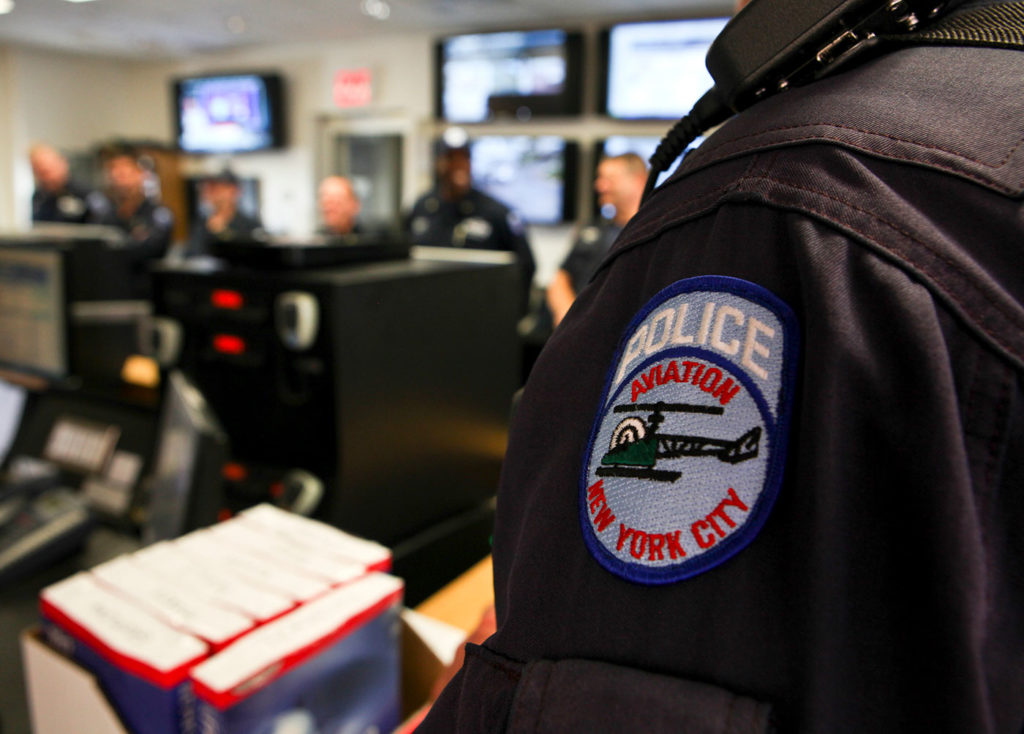
“If we’re doing a backyard search in a nice dark area, we have the offset set up where the [search] light is off to the right, so the perp will be like, ‘oh man, those guys don’t know where I’m at.’” Delacruz said. “And he moves and at nighttime, that’s best, if we can get the perp to start moving around.”
As soon as a suspect moves, the helicopter’s thermal camera picks them up. However, this is part of their brief, because the ground troops call the helicopter, and tell them that they’re looking at the wrong yard because the spotlight’s off to the wrong side. The helicopter crew basically gives a head fake of sorts to the “perp” to lure them out of hiding.
Supporting the police comes in several ways, including tactical insertions of the NYPD’s Emergency Services Unit (ESU) units, airborne use of force, and medevac if something goes wrong. The aviation unit trains with the ESU, sending crews twice per year to maintain proficiency for airborne use of force and aerial gunnery.
The mission set of the NYPD Air Unit is all encompassing. Last year the NYPD responded to over 460 rescue missions, and over 2,700 police missions. At times, the taxpayers ask what value the air unit brings. After seeing this unit perform and the number of missions executed, their operational tempo, these officers are flying their aircraft hard, saving lives, and protecting the citizens of New York. Police air operations continue to be a force multiplier, and provide the proverbial eye in the sky critical to managing complex operations.





